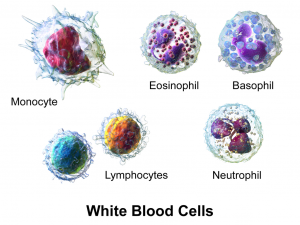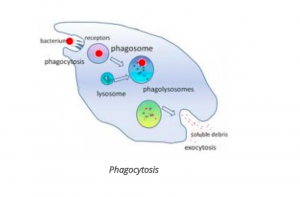Dear Fellow Peers,
The purpose of assignment is to be able to define a relatively complicated term within our respective profession for a general audience. This is done by giving a parenthetical, sentence, and expanded definition for the term. I chose the word leukocyte as I am a biology major, and I believe it to be a term that many know the definition but not the scientific term.
Parenthetical definition: His blood was high in leukocyte (protecting cells of the immune system) count.
Sentence definition: A leukocyte is a cell of the immune system that protects the body from infections and pathogens, also known as white blood cells.
Expanded definition:
Etymology
The word leukocyte comes from the Greek language. Leuk- translates into “white” and cyt translates into “cell.” This is named appropriately because of the white and clear nature of these cells. This colour is evident when cells of the blood are centrifuged, which separates them based on density.
How does it work?
Leukocytes are made in the bone marrow and reside in your circulatory and lymphatic system. There are many different types of leukocytes, each with different functions and specialties. Collectively, these leukocytes fight off foreign invaders usually through digestive enzymes that break them down or by engulfing them. When there are abnormally high pathogens in the body or an infection, there are more leukocytes in the blood.
Analysis of Parts
- Monocytes: Engulf and break down pathogen
- Lymphocytes: Made of B cells that create antibodies and T cells that destroy cells
- Neutrophils: Most common and first line of defence leukocyte that engulf bacteria.
- Basophils: responsible for allergic reaction by secreting histamine.
- Eosinophils. Destroy parasites, cancer cells, and assist in allergic reactions.
Visual

Figure 1. Types of leukocytes. Source: Blausen.com staff (2014). “Medical gallery of Blausen Medical 2014“.WikiJournal of Medicine 1 (2). DOI:10.15347/wjm/2014.010. ISSN 2002-4436.

Figure 2. The visual of bacteria being engulfed by a macrophage. Upon phagocytosis, the bacteria are exposed to digestive enzymes known as lysosomes that break it down. The debris is then released. Source: McDougall, W. (2006, July 03). Macrophages: Definition, Function & Types. Retrieved from https://study.com/academy/lesson/macrophages-definition-function-types.html
Work Cited
Bianco, C. (2000, April 01). How Blood Works. Retrieved from https://health.howstuffworks.com/human-body/systems/circulatory/blood2.htm
What Are White Blood Cells? (n.d.). Retrieved from https://www.urmc.rochester.edu/encyclopedia/content.aspx?ContentID=35&ContentTypeID=160
Leukocyte (n.). (n.d.). Retrieved from https://www.etymonline.com/word/leukocyte
Leave a Reply